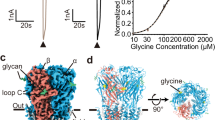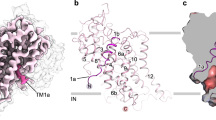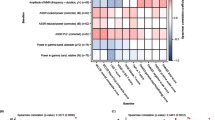Abstract
Deficient N-methyl-D-aspartate (NMDA) receptor transmission is thought to underlie schizophrenia. An approach for normalizing glutamate neurotransmission by enhancing NMDA receptor transmission is to increase glycine availability by inhibiting the glycine transporter type 1 (GlyT1). This study investigated the relationship between the plasma concentration of the glycine reuptake inhibitor bitopertin (RG1678) and brain GlyT1 occupancy. Healthy male volunteers received up to 175 mg bitopertin once daily, for 10–12 days. Three positron emission tomography scans, preceded by a single intravenous infusion of ∼30 mCi [11C]RO5013853, were performed: at baseline, on the last day of bitopertin treatment, and 2 days after drug discontinuation. Eighteen subjects were enrolled. At baseline, regional volume of distribution (VT) values were highest in the pons, thalamus, and cerebellum (1.7–2.7 ml/cm3) and lowest in cortical areas (∼0.8 ml/cm3). VT values were reduced to a homogeneous level following administration of 175 mg bitopertin. Occupancy values derived by a two-tissue five-parameter (2T5P) model, a simplified reference tissue model (SRTM), and a pseudoreference tissue model (PRTM) were overall comparable. At steady state, the relationship between bitopertin plasma concentration and GlyT1 occupancy derived by the 2T5P model, SRTM, and PRTM exhibited an EC50 of ∼190, ∼200, and ∼130 ng/ml, respectively. Emax was ∼92% independently of the model used. Bitopertin plasma concentration was a reliable predictor of occupancy because the concentration–occupancy relationship was superimposable at steady state and 2 days after drug discontinuation. These data allow understanding of the concentration–occupancy–efficacy relationship of bitopertin and support dose selection of future molecules.
Similar content being viewed by others
Log in or create a free account to read this content
Gain free access to this article, as well as selected content from this journal and more on nature.com
or
References
Alberati D, Moreau JL, Lengyel J, Hauser N, Mory R, Borroni E et al (2012). Glycine reuptake inhibitor RG1678: a pharmacologic characterization of an investigational agent for the treatment of schizophrenia. Neuropharmacology 62: 1152–1161.
Borroni E, Zhou Y, Ostrowitzki S, Alberati D, Kumar A, Hainzl D et al (2011). Pre-clinical characterization of [11C]R05013853 as a novel radiotracer for imaging of the Glycine Transporter type 1 by Positron Emission Tomography. Neuroimage e-pub ahead of print 10 December 2011. doi:10.1016/j.neuroimage.2011.11.090.
Cubelos B, Giménez C, Zafra F (2005). Localization of the GLYT1 glycine transporter at glutamatergic synapses in the rat brain. Cereb Cortex 15: 448–459.
Cunningham VJ, Matthews JC, Gunn RN, Rabiner EA, Gee AD (2004). Identification and interpretation of microparameters in neuroreceptor compartmental models. Neuroimage 22 (Suppl. 2): T13–T14.
Cunningham VJ, Rabiner EA, Slifstein M, Laruelle M, Gunn RN (2010). Measuring drug occupancy in the absence of a reference region: the Lassen plot re-visited. J Cereb Blood Flow Metab 30: 46–50.
Depoortère R, Dargazanli G, Estenne-Bouhtou G, Coste A, Lanneau C, Desvignes C et al (2005). Neurochemical, electrophysiological and pharmacological profiles of the selective inhibitor of the glycine transporter-1 SSR504734, a potential new type of antipsychotic. Neuropsychopharmacology 30: 1963–1985.
Friston K (2002). Statistical parametric mapping 2. http://www.fil.ion.ucl.ac.uk/spm/software/spm2/.
Gunn RN, Murthy V, Catafau AM, Searle G, Bullich S, Slifstein M et al (2011). Translational characterization of [(11)C]GSK931145, a PET ligand for the glycine transporter type 1 (GlyT1-1). Synapse 65: 1319–1332.
Hamill TG, Eng W, Jennings A, Lewis R, Thomas S, Wood S et al (2011). The synthesis and preclinical evaluation in rhesus monkey of [(18)F]MK-6577 and [(11)C]CMPyPB, glycine transporter 1 positron emission tomography radiotracers. Synapse 65: 261–270.
Herdon HJ, Roberts JC, Coulton S, Porter RA (2010). Pharmacological characterisation of the GlyT-1 glycine transporter using two novel radioligands. Neuropharmacology 59: 558–565.
Hilton J, Yokoi F, Dannals RF, Ravert HT, Szabo Z, Wong DF (2000). Column-switching HPLC for the analysis of plasma in PET imaging studies. Nucl Med Biol 27: 627–630.
Hofmann C, Alberati D, Banken L, Boetsch C, Ereshefsky L, Jhee S et al (2011). Glycine transporter type 1 (GlyT1) inhibitor RG1678: proof of mechanism of action in healthy volunteers. Schizophr Bull 37 (Suppl 1): 306.
Innis RB, Cunningham VJ, Delforge J, Fujita M, Giedde A, Gunn RN et al (2007). Consensus nomenclature for in vivo imaging of reversibly binding radioligands. J Cereb Blood Flow Metab 27: 1533–1539.
Javitt DC (2006). Is the glycine site half saturated or half unsaturated? Effects of glutamatergic drugs in schizophrenia patients. Curr Opin Psychiatry 19: 151–157.
Javitt DC (2007). Glutamate and schizophrenia: phencyclidine, N-methyl-D-aspartate receptors, and dopamine-glutamate interactions. Int Rev Neurobiol 78: 69–108.
Javitt DC (2009). Glycine transport inhibitors for the treatment of schizophrenia: symptom and disease modification. Curr Opin Drug Discov Devel 12: 468–478.
Koeppe RA, Holthoff VA, Frey KA, Kilbourn MR, Kuhl DE (1991). Compartmental analysis of [11C]flumazenil kinetics for the estimation of ligand transport rate and receptor distribution using positron emission tomography. J Cereb Blood Flow Metab 11: 735–744.
Lammertsma AA, Hume SP (1996). Simplified reference tissue model for PET receptor studies. Neuroimage 4: 153–158.
Lassen NA, Bartenstein PA, Lammertsma AA, Prevett MC, Turton DR, Luthra SK et al (1995). Benzodiazepine receptor quantification in vivo in humans using [11C]flumazenil and PET: application of the steady-state principle. J Cereb Blood Flow Metab 15: 152–165.
Logan J, Fowler JS, Volkow ND, Wolf AP, Dewey SL, Schlyer DJ et al (1990). Graphical analysis of reversible radioligand binding from time-activity measurements applied to [N-11C-methyl]-(-)-cocaine PET studies in human subjects. J Cereb Blood Flow Metab 10: 740–747.
Patlak CS, Blasberg RG, Fenstermacher JD (1983). Graphical evaluation of blood-to-brain transfer constants from multiple-time uptake data. J Cereb Blood Flow Metab 3: 1–7.
Patlak CS, Blasberg RG (1985). Graphical evaluation of blood-to-brain transfer constants from multiple-time uptake data. Generalizations. J Cereb Blood Flow Metab 5: 584–590.
Pinard E, Alanine A, Alberati D, Bender M, Borroni E, Bourdeaux P et al (2010). Selective GlyT1 inhibitors: discovery of [4-(3-fluoro-5-trifluoromethylpyridin-2-yl)piperazin-1-yl][5-methanesulfonyl-2-((S)-2,2,2-trifluoro-1-methylethoxy)phenyl]methanone (RG1678), a promising novel medicine to treat schizophrenia. J Med Chem 53: 4603–4614.
Pinard E, Burner S, Cueni P, Hartung T, Norcross RD, Schmid P et al (2011). Radiosynthesis of [5-[11C]methanesulfonyl-2-((S)-2,2,2-trifluoro-1-methyl-ethoxy)-phenyl]-[5-(tetrahydro-pyran-4-yl)-1,3-dihydro-isoindol-2-yl]-methanone ([11C]RO5013853), a novel PET tracer for the glycine transporter type I (GlyT1). J Labelled Comp Radiopharm 54: 702–707.
Smith KE, Borden LA, Hartig PR, Branchek T, Weinshank RL (1992). Cloning and expression of a glycine transporter reveal colocalization with NMDA receptors. Neuron 8: 927–935.
Tauscher J, Jones C, Remington G, Zipursky RB, Kapur S (2002). Significant dissociation of brain and plasma kinetics with antipsychotics. Mol Psychiatry 7: 317–321.
Uppoor RS, Mummaneni P, Cooper E, Pien HH, Sorensen AG, Collins J et al (2008). The use of imaging in the early development of neuropharmacological drugs: a survey of approved NDAs. Clin Pharmacol Ther 84: 69–74.
Wong DF, Nestadt G, Cumming P, Yokoi F, Gjedde A (2000). Partition volume and regional binding potentials of serotonin receptor and transporter ligands. In: Gjedde A, Hansen SB, Knudsen GM, Pavison OB (eds). Physiological Imaging of the Brain with PET. Academic Press: San Diego., pp 257–263.
Wong DF, Ostrowitzki S, Zhou Y, Raymont V, Hofmann C, Borroni E et al (2011). Characterization of [11C]RO5013853, a novel PET tracer for the glycine transporter Type 1 (GlyT1) in humans. Neuroimage e-pub ahead of print 1 December 2011. doi:10.1016/j.neuroimage.2011.11.052.
Zafra F, Aragón C, Olivares L, Danbolt NC, Giménez C, Storm-Mathisen J (1995). Glycine transporters are differentially expressed among CNS cells. J Neurosci 15: 3952–3969.
Zeng Z, O’Brien JA, Lemaire W, O’Malley SS, Miller PJ, Zhao Z et al (2008). A novel radioligand for glycine transporter 1: Characterization and use in autoradiographic and in vivo brain occupancy studies. Nucl Med Bio 35: 315–325.
Zhou Y, Endres CJ, Brašić JR, Huang SC, Wong DF (2003). Linear regression with spatial constraint to generate parametric images of ligand-receptor dynamic PET studies with a simplified reference tissue model. Neuroimage 18: 975–989.
Zhou Y, Resnick SM, Ye W, Fan H, Holt DP, Klunk WE et al (2007). Using a reference tissue model with spatial constraint to quantify [11C]Pittsburgh compound B PET for early diagnosis of Alzheimer’s disease. Neuroimage 36: 298–312.
Zhou Y, Ye W, Brašic JR, Crabb AH, Hilton J, Wong DF (2009). A consistent and efficient graphical analysis method to improve the quantification of reversible tracer binding in radioligand receptor dynamic PET studies. Neuroimage 44: 661–670.
Zhou Y, Ye W, Brašić JR, Wong DF (2010). Multi-graphical analysis of dynamic PET. Neuroimage 49: 2947–2957.
Acknowledgements
We thank Dr John Hilton, biochemist at Johns Hopkins University, Syed Faridi, study coordinator at PAREXEL, and Lorena Gapasin, project manager at PAREXEL, for coordinating study conduct. This study was funded by F. Hoffmann-La Roche. Support for third-party editorial assistance for this manuscript, furnished by Veronica Porkess PhD, (Complete HealthVizion), archimed medical communication ag and ApotheCom, was provided by F. Hoffmann-La Roche.
Author information
Authors and Affiliations
Corresponding author
Ethics declarations
Competing interests
At the time of the study M. Martin-Facklam, S. Ostrowitzki, N. Parkar, F. Pizzagalli, and D. Umbricht were employees of F. Hoffmann-La Roche. D.F. Wong has received compensation as a consultant for Amgen, and received funding for his work from the National Institutes of Health, Avid Radiopharmaceuticals, Biotie Therapies, GE Healthcare, Intracellular Therapies Inc, Johnson & Johnson, Eli Lilly, H. Lundbeck A/S, Merck, Orexigen Therapeutics, Otsuka Pharmaceuticals, F. Hoffman-La Roche, and Sanofi-Aventis SA. The remaining authors declare no conflict of interest.
Additional information
Supplementary Information accompanies the paper on the Neuropsychopharmacology website
Rights and permissions
About this article
Cite this article
Martin-Facklam, M., Pizzagalli, F., Zhou, Y. et al. Glycine Transporter Type 1 Occupancy by Bitopertin: a Positron Emission Tomography Study in Healthy Volunteers. Neuropsychopharmacol 38, 504–512 (2013). https://doi.org/10.1038/npp.2012.212
Received:
Revised:
Accepted:
Published:
Issue date:
DOI: https://doi.org/10.1038/npp.2012.212
Keywords
This article is cited by
-
Structural insights into the inhibition of glycine reuptake
Nature (2021)
-
Spatially constrained kinetic modeling with dual reference tissues improves 18F-flortaucipir PET in studies of Alzheimer disease
European Journal of Nuclear Medicine and Molecular Imaging (2021)
-
Imaging the glutamate synapse
Nature Medicine (2020)
-
Comparative Pro-cognitive and Neurochemical Profiles of Glycine Modulatory Site Agonists and Glycine Reuptake Inhibitors in the Rat: Potential Relevance to Cognitive Dysfunction and Its Management
Molecular Neurobiology (2020)
-
Effects of the glycine reuptake inhibitors bitopertin and RG7118 on glycine in cerebrospinal fluid: results of two proofs of mechanism studies in healthy volunteers
Psychopharmacology (2016)



